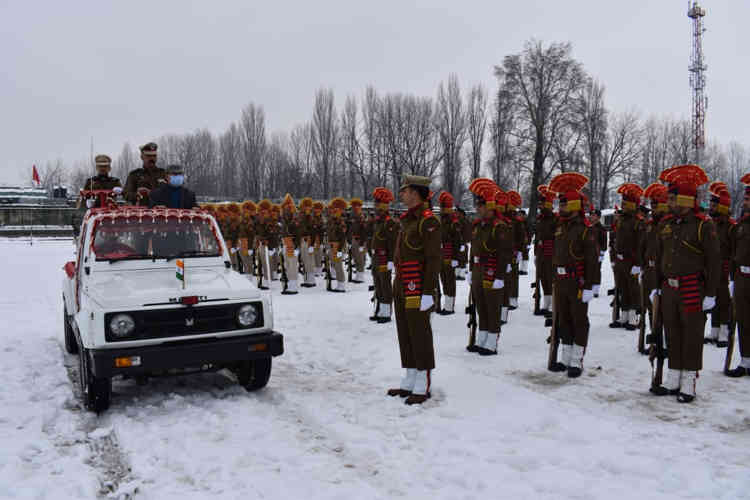In sharp contrast to an atmosphere of fear and security apprehensions that prevailed for years after 1990, Republic Day was celebrated on 26 January all over the Kashmir valley in the midst of the Chilla-e-Kalaan—the core of the four-month-long winter season.
For the first time, the Tricolour did flutter not only on the lamp posts at the Boulevard along the banks of the lake in Srinagar but also on the small island of Char Chinari where groups of tourists, led by a local councillor of the Srinagar Municipal Corporation, hoisted the national flag, sang the national anthem and danced in jubilation.
Not far away, at Gupkar Road, a group of mainstream political activists hoisted the national flag, a furlong away from the residences of the three former Chief Ministers—Farooq Abdullah, Omar Abdullah and Mehbooba Mufti—who are now spearheading a movement for restoration of the Article 370, 35-A and Statehood.
Tuesday’s celebrations were in sharp contrast to the post-1990 years when there used to be a complete shutdown in Kashmir and parts of the Jammu province on the routine calls from the militants and the separatists. Sometimes there used to be pro-Pakistan demonstrations, ceremonial parades and cricket matches.
This time around, not one untoward incident, disruptive or subversive attempt, a protest demonstration, stone pelting or a terror strike was reported from anywhere in Jammu and Kashmir. Shops and other commercial establishments remain closed under government orders on Independence Day and Republic Day. Still private vehicular traffic operated smoothly.
An Urdu portal from Pakistan reported that the ‘Kashmiris’ hoisted the Pakistani national flag behind the iron-grilled gate of Jamia Masjid in Srinagar in response to the Indian flags along the Boulevard and the Dal Lake. It carried a picture of the Pakistani flag but there was no one around.
Even as nobody from the two traditional ruling parties participated in the Republic Day celebrations, the Provincial President of Abdullah’s National Conference (NC), Devender Singh Rana, unfurled the Tricolour at the party’s Jammu headquarters of Sher-e-Kashmir Bhawan. A number of NC activists sang the national anthem. Rana was also conspicuously present at the main official ceremony at Maulana Azad Stadium. Later, Rana and NC’s Lok Sabha member from South Kashmir, Justice (retd) Hasnain Masoodi, attended the Lieutenant Governor’s at home at Raj Bhawan.
In Srinagar, leaders of the Congress party and Altaf Bukhari’s Apni Party hoisted the Tricolour at their party offices at some places.
Similar Republic Day ceremonies and celebrations were also witnessed at Srinagar Municipal Corporation, All India Radio and Doordarshan Kendra Srinagar, the Jammu and Kashmir High Court besides a number of the Union Territory government’s offices like the Directorate of Horticulture and the Directorate of Agriculture, as also some Universities, across the valley.
In Kupwara, some BJP leaders with the involvement of the local population organised a coach rally which passed through Vilgam area of Handwara with the national flag atop all the vehicles and the patriotic songs being played on the public address system. A local BJP leader, Javed Qureishi, organised a flag hoisting ceremony at his home.
In North Kashmir, the most talked about ‘civil’ ceremony was the flag hoisting at Jamia Siraj-ul-Uloom, the higher secondary school operated by the outlawed Jamaat-e-Islami. In hours of this rare event going viral in social media, there were attempts from the separatist ecosystem to project it as a ‘stage-managed show of the Indian Army’. In the wake of a controversy in the social media, a news portal reported that the show had been organised “under duress”. The organisers were quoted as alleging that Army’s Sector-12 had ‘forced’ them to put up the R-Day show.
Some of the officials maintained that it was a decades-old routine in Kashmir to silently contribute to the pro-Indian activity but blame the armed forces to ward off reprisals from the militants. “Had the Army to organise such a show, they would have done it at hundreds of places across the valley,” reasoned an officer.
Members and heads of the Panchayati Raj Institutions, Urban Local Bodies, including the recently elected member of the District Development Councils and Chairpersons of the Block Development
Councils, organised Republic Day events, including the flag hoisting, at different places.
In 1990, on the other hand, it was on the eve of the Republic Day that the four unarmed Indian Air Force (IAF) personnel were gunned down in Srinagar in 1990 and 26 Kashmiri Pandits were massacred at Wandhama, Ganderbal, in 1998.
On all such occasions, the Dukhtaran-e-Millat founder-chairperson, Asiya Andrabi, who has been languishing in Delhi’s Tihar Jail along with her associates since 2018, used to drive to the iconic Pratap Park in Srinagar where she would install the Pakistani flag. After the ‘ceremony’, she would visit the offices and residences of the local journalists with sweets and confectionaries, particularly on the Pakistan Day on 23 March and the Pakistan Independence Day on 14 August. Militants would give gun salutes to the Pakistani flag.
Much of that had vanished over the years but the militants and the separatists reclaimed their base considerably in 2015-18 when Mufti Mohammad Sayeed’s PDP-BJP government released the jailed separatist Massarat Alam. In weeks of his release, Aalam organised a massive pro-Pakistan and pro-militant demonstration on the reception of the hardliner Syed Ali Shah Geelani from Delhi to Srinagar.
Even after Aalam was re-arrested under the BJP’s pressure, the Hizbul Mujahideen militant Burhan Wani was permitted to grow as some sort of a youth icon on social media. By the time he got killed in an encounter with the security forces in July 2016, the valley had virtually slipped out of Delhi’s hands.
That cult of so-called heroism, stone pelting and total freedom to the separatist ecosystem began falling apart only after the dismissal of the PDP-BJP government in June 2018. However, the real turning points were the actions taken after the death of 40 CRPF men in a terror strike in February 2019, followed by abrogation of Article 370 and 35-A in August 2019.




















